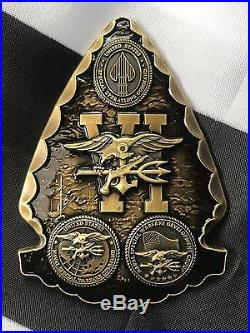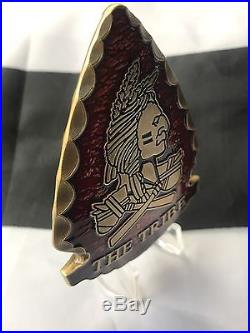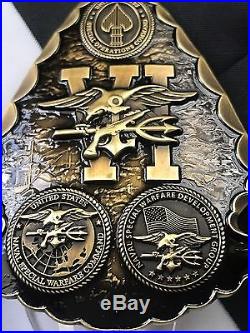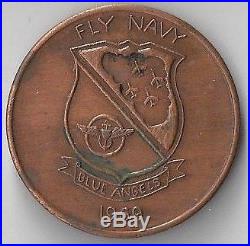
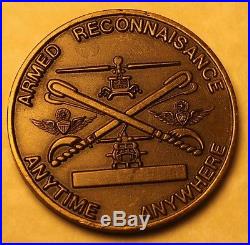

4th Squadron 17th Cavalry. Army Choppers off a Navy Vessel. Condition: Used, and in good shape. It is 1 5/8 inches in diameter. This unit was only around a few years. On 16 January 1991, the 4th Squadron, 17th Cavalry Regiment (Air) (Recon) reactivated from Task Force 118. The unit was redesignated to the 4th Squadron, 2nd Armored Cavalry regiment on 15 January 1994. On 2 august 1990 when Iraq invaded Kuwait, the unit continued operations in the gulf as a part of the maritime interdiction force in support of Operation Desert Shield. During Operation Desert Storm, the 4/17th Cavalry. Distinguished itself by capturing the war’s first Iraqi prisoners and recapturing the first piece of Kuwaiti territory. The squadron also participated in the liberation of the U. And British embassies in Kuwait city. When it redeployed to Fort Bragg in October 1991, the Squadron had flown over 6500 night vision goggle hours, escorted 500 ships, and operated from 47 naval combatants in the north Arabian gulf. The 4/17th cavalry stood up and stood ready for its world wide contingency mission as the “Eyes and Ears” of the XVIII Airborne Corps. The unit was redesignated as the 4/2d Armored Cavalry Regiment January 16, 1994. The Persian Gulf heated up again with the Iraqi invasion of Kuwait in August 1990, and the Army helicopters were part of the Desert Shield naval buildup. TF-118 officially became the 4th Squadron, 17th Cavalry Regiment within the 18th Aviation Brigade of the XVIII Airborne Corps on 15 January 1991. A and B Troops of the 4/17th flew throughout Desert Shield and Desert Storm. On 18-19 January, B Troop OH-58Ds were on hand to claim the first Iraqi prisoners of war from armed oil platforms in the Persian Gulf. On 26 January, two B Troop helicopters left the USS CURTS to investigate a potential minelayer. They were diverted to an Iraqi-held island where they ultimately liberated the first piece of Kuwait and took 29 more prisoners. During the second week in February, a troop with the help of a handheld GPS receiver entered Kuwait with US Special Forces. Night vision goggles were blinded by the dense smoke of burning oil wells, but the FLIR in the mast mounted sights made it possible to see about a quarter mile ahead and avoid Kuwaiti powerlines. The armed scouts encountered only surrendering Iraqis and were on hand for the liberation of the US and British embassies in Kuwait City. At sea, night-capable attack helicopters aboard Navy ships extended the reach of our naval forces. They were sent about 40 miles north to perform bomb damage assessment on an Iraqi Silkworm site hit by Navy A-6 Intruders. A’scramorder’ rushed them out of the area as the carrier jets struck again. The two helicopters refueled aboard JARRETT and were launched once more with Hellfires and a more complete target briefing. An unmanned air vehicle (UAV) from the battleship USS MISSOURI found the site had survived the second bombing, and the Sea Cav crews were ordered to attack. They flew north again on instruments and made a first pass in the area to orient themselves. The Hellfire launched on the second pass went ballistic, but the missile fired on the third pass hit and destroyed the Silkworm launcher. Another UAV confirmed the target had been destroyed and revealed the first missile had hit an ammunition dump. The strike paved the way for an important deception, which enabled the naval task force and amphibious assault force to run their feint attack in the Gulf. The McDonnell Douglas Mast Mounted Sight with thermal imager, low light television, and laser range-finder/designator made the over-water scouting mission possible. The same sight was installed on ships operating in the Gulf. Contacts could be identified at 10 miles or more, depending on conditions. The MMS enabled helicopter crews hidden in darkness to observe contacts from a safe distance and fire on confirmed targets with a choice of standoff weapons. Most overwater surveillance missions were flown with gun and rockets. Heavy Hellfires were carried only for specific missions. Air-to-air Stingers had some capability against hot IR surface targets, but they were rarely used. The choice of OH-58D weapons depended on the mission and the pilot. Hydra 70 rockets with multipurpose submunition, flechette, or point-detonating, high explosive incendiary warheads could be mixed within the same seven-shot pod. Generally, rockets were used on targets beyond 1,000m and the gun closer in, however the rockets were also effective at closer ranges. Unguided area weapons could be aimed with or without the help of the MMS. If the left-seater locked the sight on thetarget, the pilot could center the aimpoint on his panel display and read the target azimuth. Elevation was adjusted to suit the weapon. Tracer rounds from the. 50 caliber machinegun could actually be seen on the FLIR displays. The ancient but effective M2 machine gun was modified to be electrically armed and de-armed. It fires 700 to 800 rounds a minute. The Prime Chance OH-58Ds are shielded to the US Navy’s200 V/m electromagnetic vulnerability standard. Likewise, SeaCav weapons are cleared to shipboard HERO (Hazards of Electro-magnetic Radiation to Ordnance)standards. The firing electronics and Mk 66 Mod 2 motor of the Hydra 70 rocket are HERO rated, but the M261 submunition had only provisional clearance for shipboard use by the 17th of April. The OH-58Ds always launched in pairs and they routinely worked with Navy LAMPS I Seasprites or LAMPSIII Seahawks to detect and investigate elusive threats. The Seahawk, with its APS-124 search radar was the preferred team-mate. The OH-58Ds typically flew out front, with one slightly higher than the other, both trailed by the Navy LAMPS helicopter flying higher still to make use of its search radar. The only modification to the shipswere new deck markings to turn the single-spot LAMPS deck into a two-spot flight deck. With main rotors unfolded and the LAMPS helicopters already flying or in the hangar, the two OH-58Ds were usually parked at opposite corners ofthe deck. Sea Cav pilots learned to fly most of the time below 50 ft to maintain a surface reference through NVGs. Above 50 to 60 ft, the sea surface loses texture and gives the aviator no external reference at night. Ideally, water with a slight’chop’ provides awell-defined surface, but thermal inversions trap dust and humidity. Gulf haze makes NVG flying all themore difficult. NVG conditions in the Gulf varied dramatically. In the words of DesertStorm pilot CW2 Al Davis,’If the water’s real smooth, it becomes like a mirror. You can see stars reflecting off the water just as you’d see them up in the sky. If there’s much of a haze, or dust, or smoke in the air, you lose your horizon. It’s like a ping-pong ball from the inside. It’s dark green on the bottom and light green on the top and there’s no change. There’s no visual horizon at all. And there are so many conditions in between, it’s hard to imagine how hard it can be to fly over water sometimes. We have no autopilot. You’ve got to fly the thing all the time. The Prime Chance aircraft had no NVG head-up displays, and crews typically kept the radar altimeter “bug” set at 20 ft to provide an audible warning if they went too low. The other extreme is on a full-moon night with about a two-foot seastate, you can see beautifully. It’s absolutely beautiful. Pilots qualified in both right and left seats, and once at sea regularly swapped seats and rotated crews to spread workload and experience. The OH-58D left-seater usually operated the Mast Mounted Sight and radios which allowed the pilot to keep his eyes out of the cockpit. Both crewmembers kept their ANVIS goggles down throughout the mission, looking under the eye tubes to see the cockpit displays. Navy smallboys with two lounges could typically bunk four aviators in one room and six enlisted maintainers in the other. During the war, crews and maintainers often slept in the LAMPS hangar to stay near their gasmasks. Gulf deployments were 35 to 50 days for pilots and 45 to 75 days for enlisted maintainers. The two-helicopter detachment included four commissioned or warrant officer pilots, two crewchiefs, one armament specialist, one avionics specialist, and an electrician, all cross-trained to assist one another. The armed scouts finally left the unsettled Gulf in October 1991, but the US Army’s first Corps-level armed reconnaissance squadron has refined its maritime capability. The XVIII Airborne Corps now routinely puts Sea Cav detachments aboard LAMPS ships. The current OH-58D Kiowa Warrior productionized the Prime Chance modifications and added even more capability with Multi-Purpose Light Helicopter kits. They can also provide armed escort for LAMPS SAR missions, and fly precision strikes against coastal point targets. Kiowa Warriors covered boarding search-and-seizure operations around Haiti during the blockade. The frigate USS STARK and otherships have sailed with three OH-58Ds when Seahawk helicopters were not deployed. Sea Cav pilots can never forget they are flying on a single engine, and in the words of one Kiowa Warrior pilot, If it quits, we’re wet. The FLIR and Hellfire kits planned for the SH-60B and the Night Targeting System now on the AH-1W have given the Navy and Marines some of the capabilities of the Kiowa Warrior. But until those systems are fully deployed by the fleet, the Navy will continue to call on Army aviators who can fly and shoot at night. Frank Colucci does editorial, marketing and technical writing for aerospace and advanced technology issues. Note: This unclassified article was written by Frank Colucci for the Rotor Review Magazine. Never personally given any of the coins. All coins are guaranteed to be in excellent condition unless otherwise specified above. The free listing tool. The item “4th Squadron 17th Cavalry Armed Recon Desert Storm Army Navy Challenge Coin” is in sale since Wednesday, December 31, 2014. This item is in the category “Collectibles\Militaria\Current Militaria (2001-Now)\Original Items\Challenge Coins”. The seller is “rolyat11″ and is located in Panama City, Florida. This item can be shipped worldwide.




